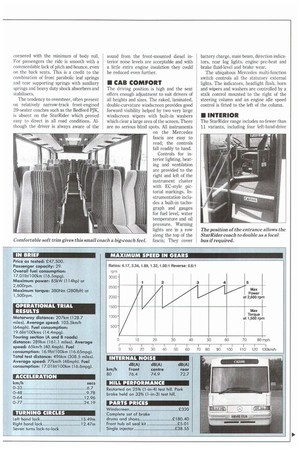MERCEDES
Page 24

Page 25

If you've noticed an error in this article please click here to report it so we can fix it.
81 1 RD COACH
• Coaches with fewer than 30 seats have long been the Cinderellas of the British PCV industry. Operators have been forced to choose between either short versions of full-size heavyweights — with their high running costs and purchase prices — or up-rated buses based on truck-derived chassis.
At first sight the Optare StarRider coach falls into the high-spec bus category, but further acquaintance reveals virtues that make it almost the ideal compromise. Over our Wye Valley coach test route the Mercedes-Benz 811D-based StarRider comfortably equalled the journey times of more powerful 12m coaches and got very close to their standards of comfort too.
Our 29-seat test vehicle was fitted with Optare's Luxury Coach Special package which includes a fully carpeted floor, fulldraw curtains and forced air ventilation through full-length fabric trimmed parcel racks.
On the 496km test route the StarRider provided a number of pleasant surprises. It was capable of cruising comfortably on motorways at the legal limit, and even at that speed was equally pleasant to ride in and drive.
Any preconceived ideas about the instability of truck-derived coaches were quickly dispelled at the Surrey test track where the StarRider proved sure-footed on the demanding ride-and-handling section. It also did well on our other set piece tests, includ ing the 25% (1-in-4) hill start test, although its performance here was obviously helped by the absence of a payload.
Emergency braking tests proved the worth of the combination of the servoassisted front discs and rear drums which brought the vehicle to a halt in a straight line every time. However, the wheels did lock up during our 64kmili stop test.
On the road braking is responsive and smooth with the quiet exhaust brake providing a useful boost to light use of the service brakes.
The stability of the vehicle on the track was confirmed on the main test route: it seemed unaffected by crosswinds or turbulence created by other large vehicles. The power steering was positive and light, with just the right amount of feel.
The StarRider is equally at home off the motorway with car-like handling qualities. The 85kW (I14hp) four-cylinder turbocharged 0M364A diesel is crisp and flexible; and the gear change from the all-synchromesh five-speed Mercedes-Benz gearbox is slick and positive. The ratios are well suited to coach use and the clutch is light.
On all types of road, including the windy and hilly stretches of B-road between the Forest of Dean and Ross-on-Wye, we were able to maintain reasonable cruising speeds. Roadholding was impressive and the coach cornered with the minimum of body roll. For passengers the ride is smooth with a commendable lack of pitch and bounce, even on the back seats. This is a credit to the combination of front parabolic leaf springs and rear supporting springs with auxiliary springs and heavy duty shock absorbers and stabilisers.
The tendency to oversteer, often present on relatively narrow-track front-engined 29-seater coaches such as the Bedford PJK, is absent on the StarRider which proved easy to direct in all road conditions. Although the driver is always aware of the sound from the front-mounted diesel interior noise levels are acceptable and with a little extra engine insulation they could be reduced even further.
• CAB COMFORT
The driving position is high and the seat offers enough adjustment to suit drivers of all heights and sizes. The raked, laminated, double-curvature windscreen provides good forward visibility helped by two very large windscreen wipers with built-in washers which clear a large area of the screen. There are no serious blind spots. All instruments on the Mercedes fascia are easy to read; the controls fall readily to hand.
Controls for interior lighting, heating and ventilation are provided to the right and left of the instrument cluster with EC-style pictorial markings. Instrumentation includes a built-in tachograph and gauges for fuel level, water temperature and oil pressure. Warning lights are in a row along the top of the fascia; They cover battery charge, main beam, direction indicators, rear fog lights, engine pre-heat and brake fluid-level and brake wear.
The ubiquitous Mercedes multi-function switch controls all the statutory external lights. The indicators, headlight flash, horn and wipers and washers are controlled by a stalk control mounted to the right of the steering column and an engine idle speed control is fitted to the left of the column.
• INTERIOR
The StarRider range includes no fewer than 11 variants, including four left-hand-drive












































































